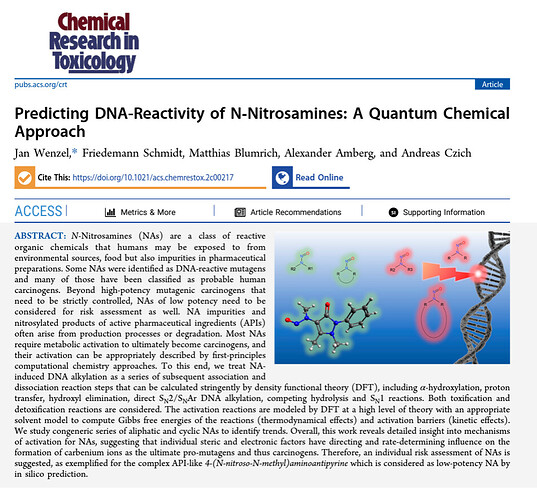Publication by Wenzel et al. (2022) “Predicting DNA-Reactivity of N-Nitrosamines: A Quantum Chemical Approach”
N -Nitrosamines (NAs) are a class of reactive organic chemicals that humans may be exposed to from environmental sources, food but also impurities in pharmaceutical preparations. Some NAs were identified as DNA-reactive mutagens and many of those have been classified as probable human carcinogens. Beyond high-potency mutagenic carcinogens that need to be strictly controlled, NAs of low potency need to be considered for risk assessment as well. NA impurities and nitrosylated products of active pharmaceutical ingredients (APIs) often arise from production processes or degradation. Most NAs require metabolic activation to ultimately become carcinogens, and their activation can be appropriately described by first-principles computational chemistry approaches. To this end, we treat NA-induced DNA alkylation as a series of subsequent association and dissociation reaction steps that can be calculated stringently by density functional theory (DFT), including α-hydroxylation, proton transfer, hydroxyl elimination, direct SN2/SNAr DNA alkylation, competing hydrolysis and SN1 reactions. Both toxification and detoxification reactions are considered. The activation reactions are modeled by DFT at a high level of theory with an appropriate solvent model to compute Gibbs free energies of the reactions (thermodynamical effects) and activation barriers (kinetic effects). We study congeneric series of aliphatic and cyclic NAs to identify trends. Overall, this work reveals detailed insight into mechanisms of activation for NAs, suggesting that individual steric and electronic factors have directing and rate-determining influence on the formation of carbenium ions as the ultimate pro-mutagens and thus carcinogens. Therefore, an individual risk assessment of NAs is suggested, as exemplified for the complex API-like 4-(N-nitroso-N-methyl)aminoantipyrine which is considered as low-potency NA by in silico prediction
